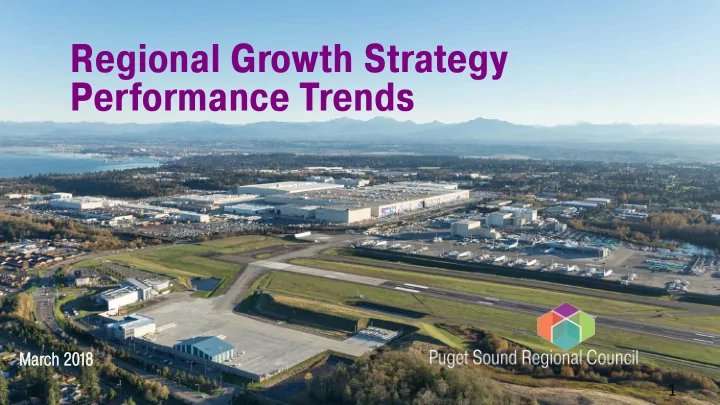

Regional Growth Strategy Performance Trends Mar March ch 20 2018 1
Regional Growth Strategy VISION 2040 Regional Geographies and Centers The central Puget Sound region has grown rapidly, adding 376,000 people since 2010 and is now home to over 4 million people. VISION 2040 , which was adopted in 2008, is a comprehensive strategy to manage that growth. The Regional Growth Strategy guides most employment and housing growth to the region’s largest cities and urban centers. Metropolitan Cities , which play central roles in each county, include Seattle, Bellevue, Tacoma, Everett, and Bremerton. Core cities are cities with regional growth centers and include cities such as Renton, Bothell, and Puyallup. Other Larger and Small cities are defined based on current population and employment. Achieving the strategy as we grow will help to protect rural and resource lands, invest in existing communities, provide access to regional transit, and address climate change. Comparing recent trends with the strategy is one way to measure how we are doing in achieving the VISION 2040 goals. 2
RGS Performance Trends VISION 2040 was adopted in 2008, with a planning base year of 2000. Phased implementation of VISION 2040 occurs through Countywide Planning Policies and local comprehensive plans, a process which recently concluded in 2016. The following slides show the distribution of actual population and employment growth compared with the pattern of growth called for in the Regional Growth Strategy, focusing on: • Distribution of growth across counties and regional geographies • Data for the region as a whole as well as for each county • Long-range and short-term trends The trend analysis summarized here supports the VISION 2050 planning process, in particular consideration of the following: • Areas where actual growth aligns with the strategy • Areas with significant gaps between recent trends and VISION 2040 • Factors that have influenced recent growth trends • Potential modifications to the Regional Growth Strategy as it is extended to 2050 • Future actions to better align residential and employment growth with the regional plan 3
Distribution of Growth Reg Regio ionwide – Reg Regio ional G l Geo eographies es 4
Distribution of Growth Reg Regio ionwide – Reg Regio ional G l Geo eographies es (time time se serie ries) s) 5
Distribution of Growth Reg Regio ionwide – Counties ies 6
Distribution of Growth Reg Regio ionwide – Counties ies (time time se serie ries) s) 7
Distribution of Growth King King C Coun unty – Regi gion onal Ge Geogr ographies 8
Distribution of Growth Kit Kitsap C Coun unty – Reg Regio ional G l Geo eographies 9
Distribution of Growth Pier ierce C Coun unty – Reg Regio ional G l Geo eographies 10
Distribution of Growth Sno nohomis ish C h Count unty – Reg Regio iona nal G Geo eographie ies 11
How is the growth strategy working? The data presented in the preceding slides show that, overall, the regional is experiencing an increase in population and employment locating in urban areas, cities, and centers, and declining growth within rural and resource lands. • Population and employment growth in Metropolitan Cities has surged since 2008, led by growth in Seattle and Bellevue. • Core Cities have seen steady growth since 2000, slightly below VISION 2040. • Larger Cities’ growth since 2000 aligns with VISION 2040 with some slowing since 2010. • Small Cities and Urban Unincorporated Areas (UUGA) are adding more population and jobs than planned for in VISION 2040, but at a declining rate since 2008. Importantly, these findings reflect trends averaged for the entire region, and mostly reflect patterns in King County, where much of the new growth has occurred. However, the pattern of actual development in Pierce, Snohomish, and Kitsap counties, at least so far, looks different from King County. Metropolitan and Core cities in those counties, which includes places such as Everett, Tacoma, and Lynnwood, have generally grown slower than called for in VISION 2040. Unincorporated areas have continued to grow more rapidly than called for in VISION 2040. PSRC will continue to evaluate actual development trends, along with other relevant data points, as work proceeds toward updating and extending the Regional Growth Strategy in VISION 2050. 12
Recommend
More recommend